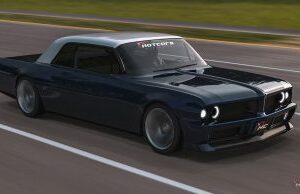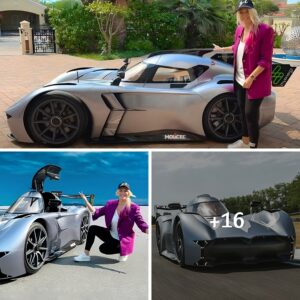Oh, the possibilities!
The array of buttons on the steering wheel of the 2023 Porsche 911 GT3 RS boggles the mind with visions of finding the perfect tune for the perfect lap. From the tiller, I can not only pick the drive mode, but also adjust both the compression and rebound of the front and rear dampers through eight settings each, chose the locking percentage of the electronic limited-slip rear differential both on and off throttle, manually adjust a Formula 1-style Drag Reduction System (DRS), and pick from eight settings for the traction and stability control.
It’s heady stuff: confusing, daunting, and exhilarating all at once.
The roughly three-mile track that poses the possibility of a perfect lap is a combination of the North and Desert courses at The Thermal Club, outside of Palm Springs, California, and the pro at the wheel of the lead car demonstrating the perfect line is either Patrick Long or Jörg Bergmeister, two long-time Porsche Works drivers.
I’ll have three cracks at finding the perfect lap. Engage!
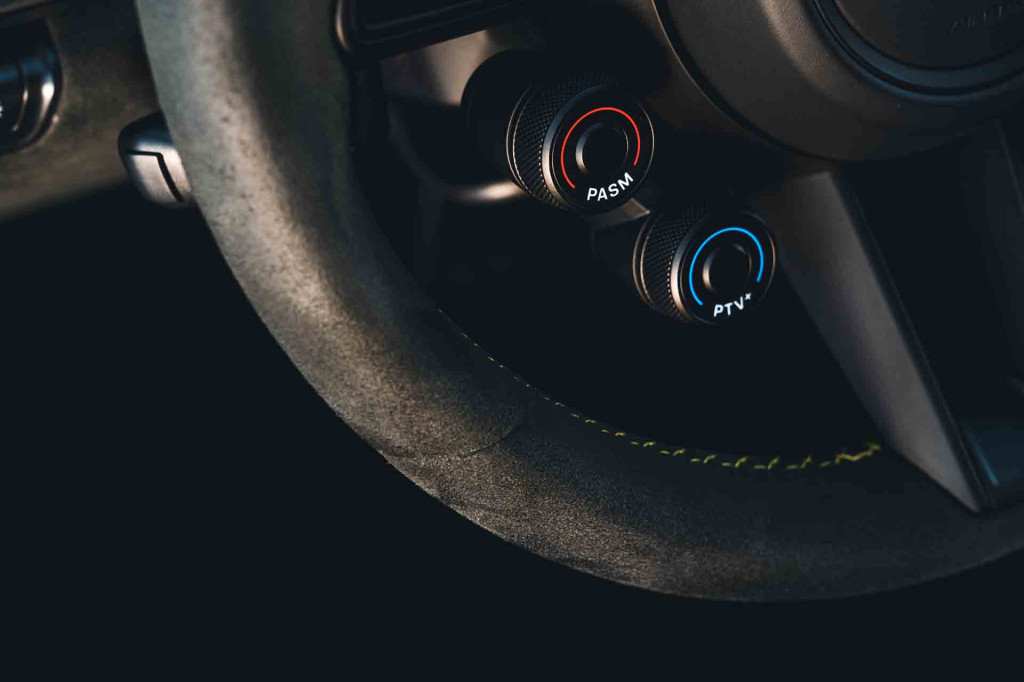

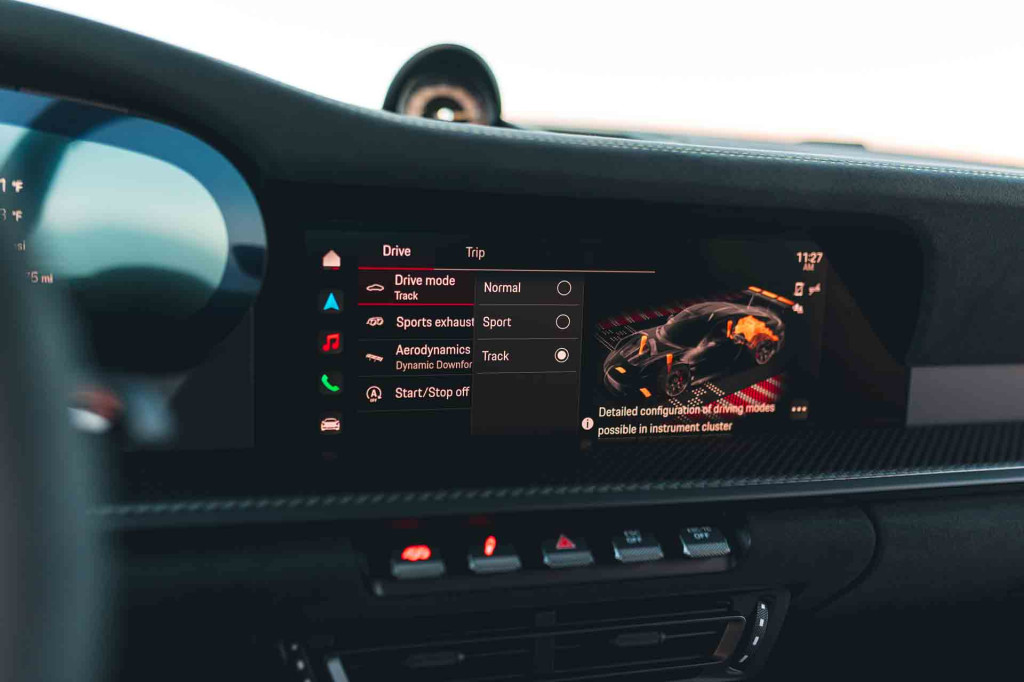

Session 1: Tracking the 911 GTS RS in default Track mode
For my first run, I opt for the recommended Track mode and leave the fine-tuning for later. The default settings are 0 for the damper rebound and compression front and rear (on a scale of -4 to +4), 0 for the eLSD both on throttle and off (also on the -4 to +4 scale), On for the traction control and Dynamic for the stability control (there are also Off settings and 1-7 subsettings). The DRS is in Dynamic Downforce instead of Low Downforce mode.
I trust these settings as they were used for 95% of the car’s development, and the development driver just happened to be Bergmeister, who is driving the lead car.
As we enter the track, the white 911 GT3 RS gets up to speed quickly and in a way that few cars can match. The naturally aspirated 4.0-liter flat-6 screams a throaty howl through less sound deadener as it winds its way up to its high 9,000-rpm redline. The flat-6 uses new camshafts with modified cam profiles and a motorsports-derived single-throttle intake with solid cam followers to increase output by 16 hp versus the standard GT3, for a total of 518 hp.
While the GT3 RS is fast, with a 0-60 mph time of a claimed 3.0 seconds, the power doesn’t hit immediately like it does in a turbocharged car. Peak horsepower arrives at 8,500 rpm and the relatively low 343 lb-ft of torque maxes out at 6,300 rpm, so the sensation is strong but not violent initial acceleration followed by power that builds relentlessly as long as my foot stays in it.
The power flows to the rear wheels through a 7-speed dual-clutch transmission rather than an 8-speed like other 911s. It has shorter gear ratios and it weighs 44 pounds less than the 8-speed, which both play into the GT3 RS’s track mission.
The acceleration is a thrill, but stopping and cornering are where this car is meant to shine.
My test car for these first few laps has the standard iron brakes, which comprise 16.1-inch front rotors with 6-piston calipers and 15.0-inch rear rotors with 4-piston calipers, but more than mechanical friction is helping the car slow down. The DRS can generate downforce equal to the weight of an NFL offensive line plus a blocking tight end.
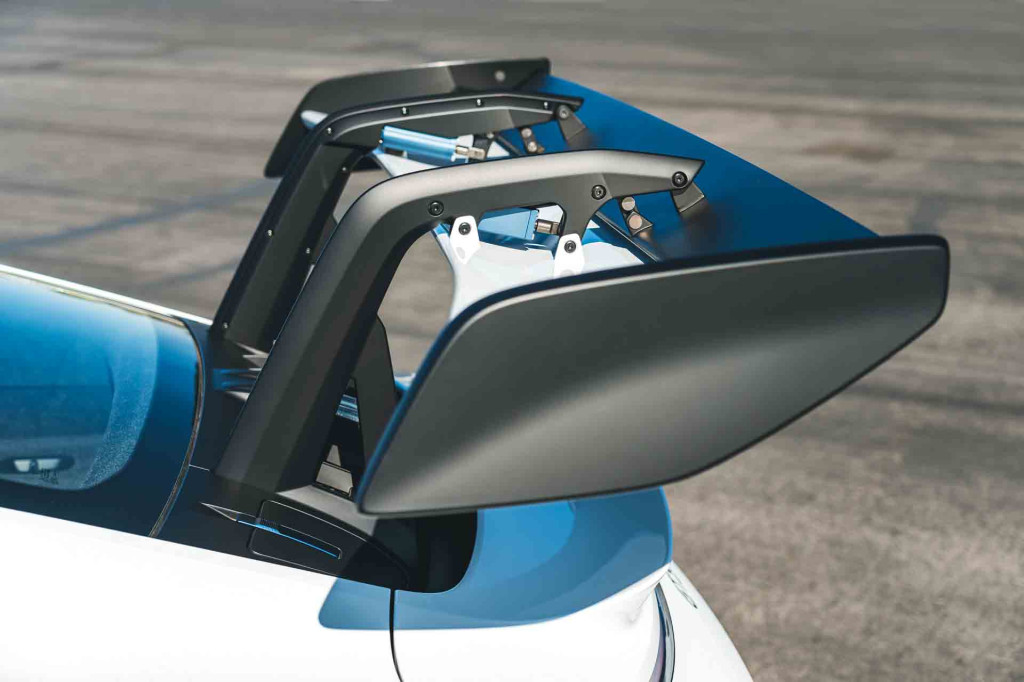
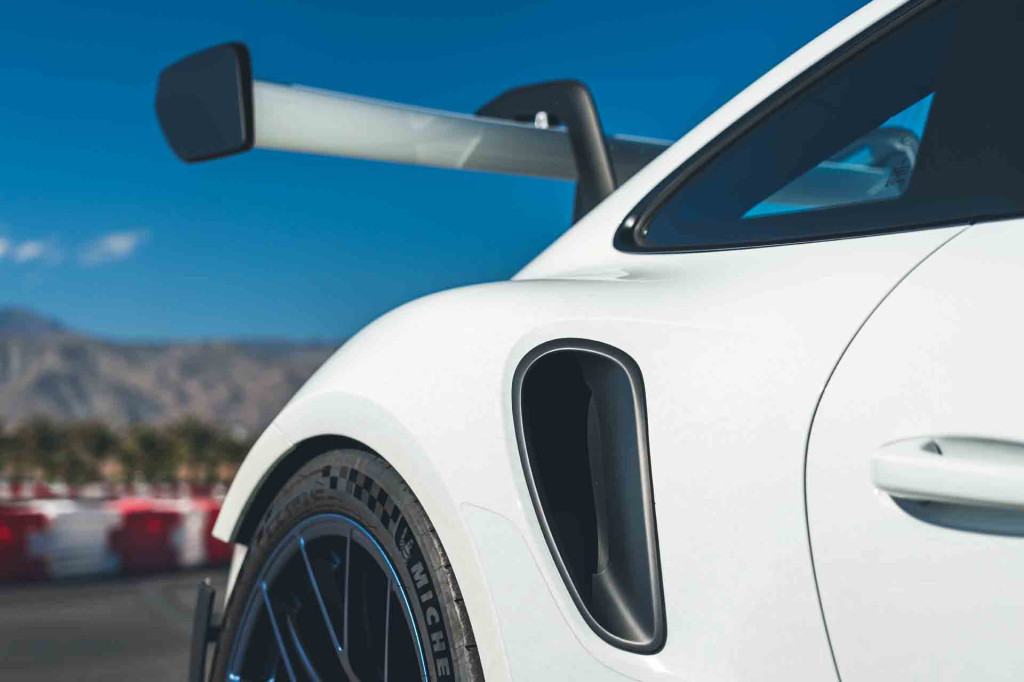

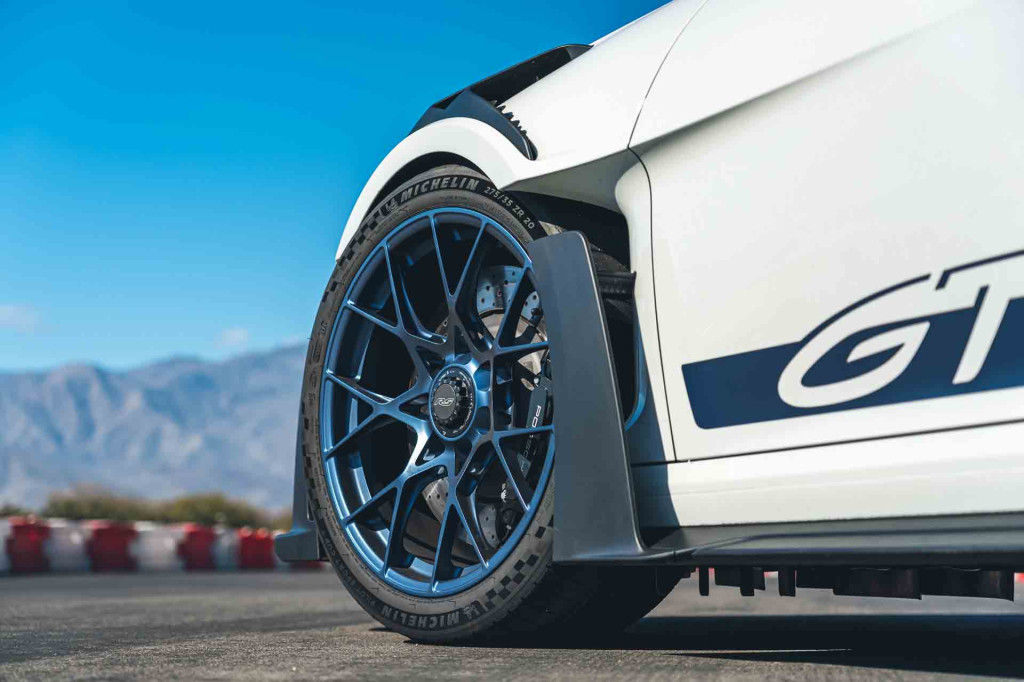
Yes, all told, the DRS and other aero measures produce a maximum of 1,895 pounds of downforce at 177 mph, twice as much as the 991.2 GT3 RS from 2019 and three times that of the current 992 GT3. I’m not coming close to that speed or the 184-mph top speed, but the car makes 895 pounds of downforce at 124 mph and a few quick glances show that I’m topping 130 mph on this track. By my calculations, it’s like three of those linemen are helping the car stop, and maybe one or two of them are pushing it to the pavement in the corners. A series of ducts and scoops, plus a front wing under the nose, a rear diffuser, and a massive rear wing create all that downforce—and achieving it took some clever workarounds.
A revised cooling system enables much of the car’s aerodynamics. Rather than three front radiators as used in other 911s, the GT3 RS has a single center-mounted front radiator that offers 32% less cooling area but is robust enough to handle all of the necessary front cooling duties.
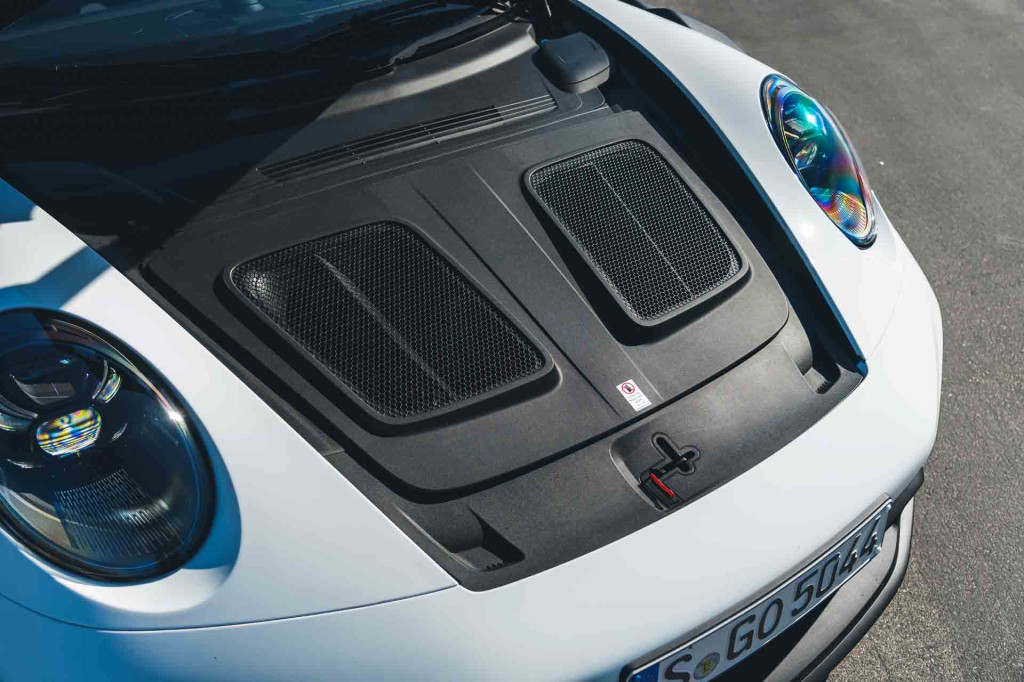
The single radiator opens the outer front air intakes for airflow that generates downforce by pushing the air up through a pair of nostrils in the center of the hood. That equipment takes up the space normally used by the frunk, so there is no front storage. It also exposes the front suspension components to airflow, so Porsche redesigned the double front wishbones with a wind-cheating teardrop shape that helps them add up to 88 pounds of downforce.
The two-piece front wing under the nose is electrically adjusted. It can flatten out or tilt in 0.3 second to increase front downforce by 80% in conjunction with the rear wing that helps create up to 1,322 pounds of downforce at the rear. When the front wing tilts, a hydraulically adjusted blade of the two-piece rear wing tilts forward 34 degrees to act as an airbrake. This blade reacts within 0.35 second.
While I could control the DRS via a scroll dial on the steering wheel, I don’t have to worry about it because Dynamic Downforce automatically adjusts the front and rear wings for optimal longitudinal and lateral dynamics. Even if Low Downforce were engaged, the system works automatically if the speed is over 62 mph, the throttle pedal is pushed to at least 95% of its travel, the revs top 5,500 rpm, and lateral acceleration isn’t in excess of 0.9 g.
Chasing Bergmeister, I’m making most of that happen as often as possible and he’s encouraging it.
Other aero is at work, too. The GT3 RS uses the widebody from the Turbo, and rather than engine cooling, the ducts in front of the rear wheels provide brake cooling while reducing air resistance at the rear. Side blades at the front and rear wheels improve downforce by allowing air to flow out from the wheelwells, as do louvers above the front tires. Air warmed by the radiator flows through the front nostrils and is directed to the sides of the car by air blades on the roof. This ensures that cooler air flowing over the body will enter the engine cooling duct forward of the trunk lid.
I can’t say I feel the effects of the car’s incredible downforce either during braking or in the corners. That takes a racer’s feel, but it’s probably helping me maintain more speed through corners. The standard iron brakes are more than holding up their end of the bargain, providing a firm pedal and strong stopping power time and time again.
As for the corners, the 911 GT3 RS feels like an even more capable version of other 911s I’ve driven on the track. The 992-generation Porsche 911 is seemingly perfect in its imperfection. The engine hangs off the back of the car behind the rear axle where it should cause the rear end to step out of line, yet somehow the car attacks corners with balance and stability.
In the 911 GT3 RS, that unmistakable stability and neutral balance is there—there’s just more of it, and springs 50% stiffer than those in the GT3 limit the 911’s already limited body lean. The Turbo’s widebody accommodates a 1.14-inch wider track and tires that are 20 mm wider—275/35R20 front and 335/30R21 rear. Standard rear-wheel steering contributes to the stability by steering slightly with the front tires through high-speed corners, and helps the car cut a sharper line through low-speed corners by turning up to 1.5 degrees opposite the fronts.
On this car, the tires are the standard sticky Michelin Pilot Sport Cup 2s, and Porsche also offers even stickier Sport Cup 2R tires. For the most tire contact patch on the track (which is already aided by those wider tires), Porsche has set up the car in the recommended track alignment with -2.45 degrees of camber at each tire instead of the standard -1.3 degrees.
I’m leery of exceeding the car’s expansive limits, but the Michelins just grip, the car rotates predictably through corners, and it’s easy to put the power down to rocket from one corner to the next. At the end of the first session, my confidence is starting to build, but I still don’t know how all the steering-wheel adjustments can affect the car’s handling character…yet.
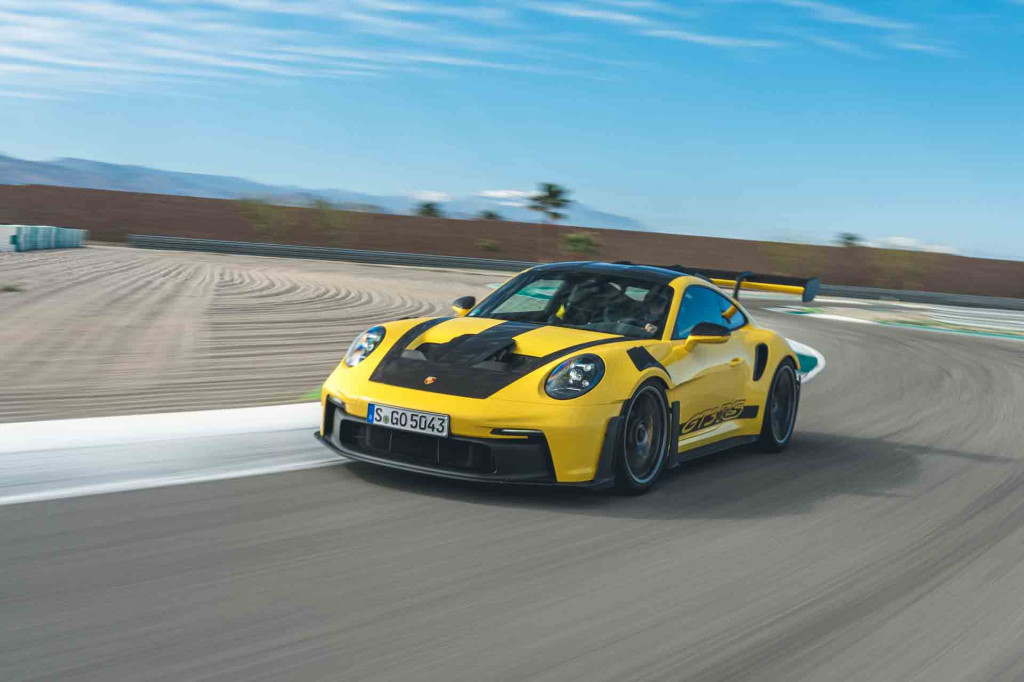
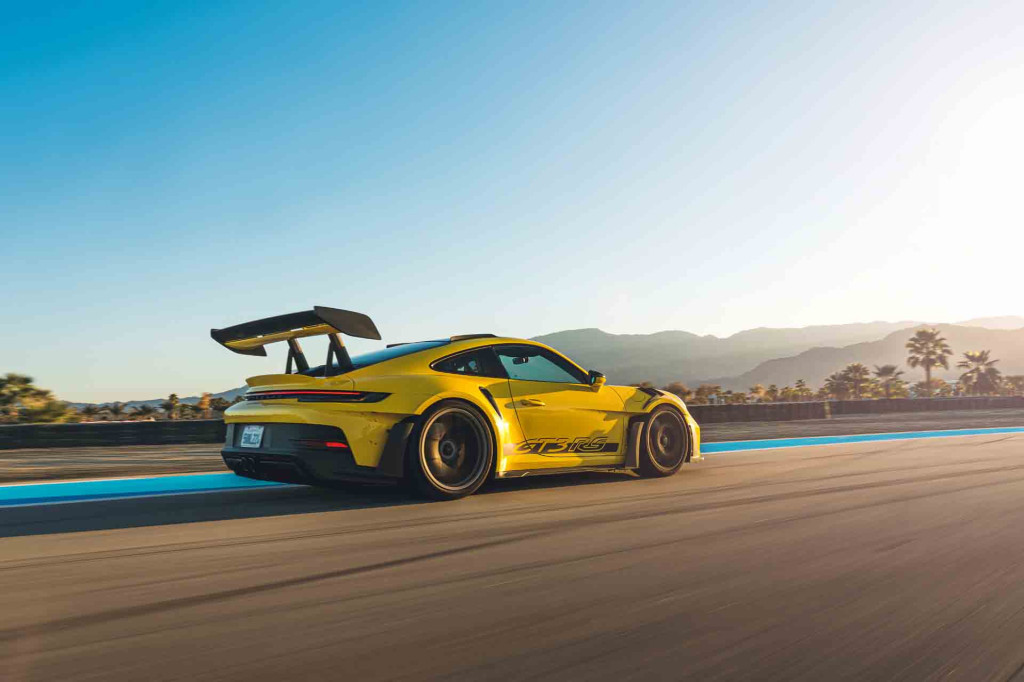
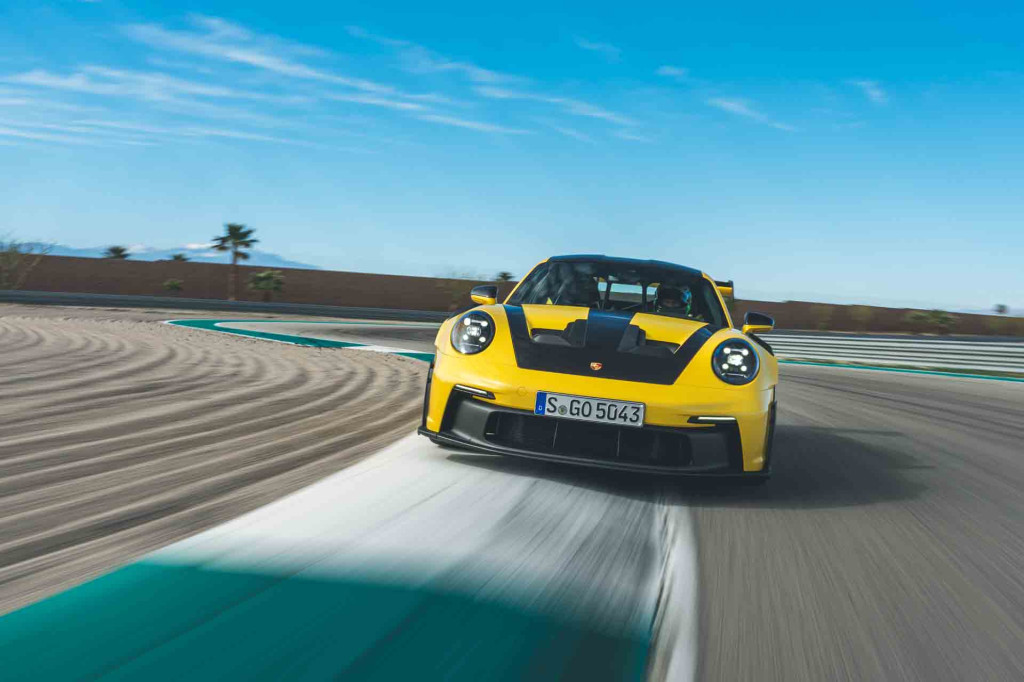
Session 2: Tracking the 911 GTS RS with damper adjustments
The next time out, I dial in a formula prescribed by Bergmeister. To get the car to turn in better, he instructs me to put more weight on the nose and take it off the rear. He suggests a -2 (softer) front compression setting, 0 front rebound, +2 rear compression (firmer), and a +3 rear rebound. For now, he says, don’t mess with the differential settings. Before the run, I hit the PASM button on the steering wheel and use all four of the steering wheel dials to make the adjustments.
This time I’m following Long, and I’m in a yellow car with the $33,520 Weissach Package. To save weight, every 911 GT3 RS uses carbon-fiber reinforced (CFRP) plastic for the doors, front quarter panels, hood, roof, and seat shells. The Weissach Package saves about 49 pounds by using carbon-fiber-reinforced plastic for the front and rear anti-roll bars, rear coupling rods, and rear shear panel, and switching to forged magnesium wheels, which save 17.6 pounds on their own. From the outside, the package announces itself with a carbon-fiber weave finish on the hood, roof, side mirrors, and parts of the rear wing. The interior gets magnetic shift paddles borrowed from motorsports and a Weissach insignia. As a Euro-spec model, this car also has a bolted-in carbon-fiber roll bar behind the front seats that we won’t get in the U.S.
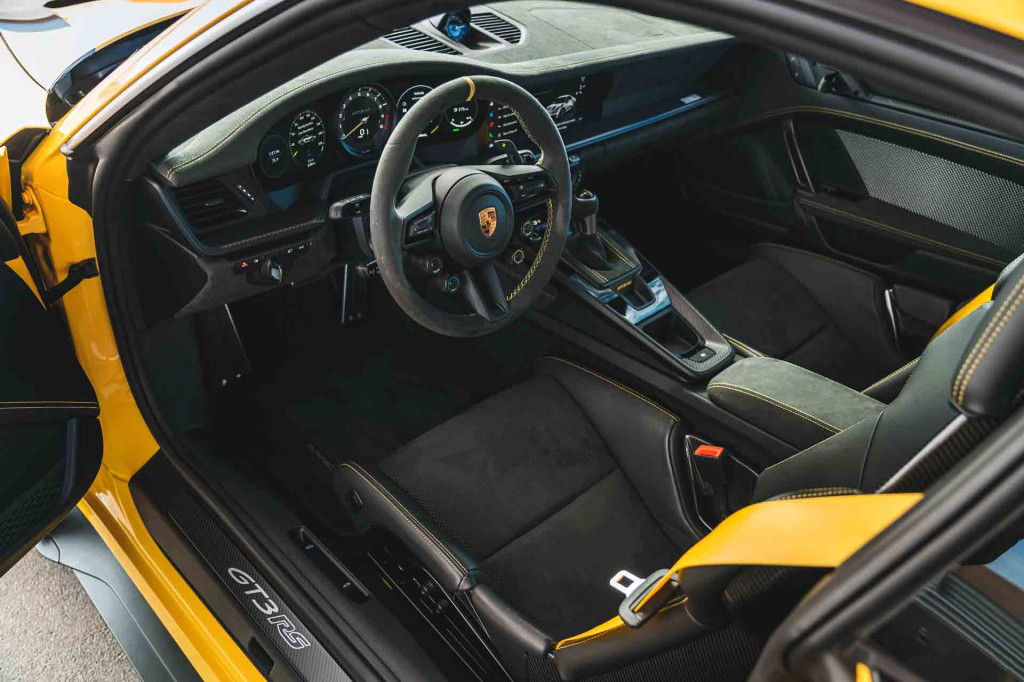 2023 Porsche 911 GT3 RS with Weissach Package
2023 Porsche 911 GT3 RS with Weissach Package
With the Weissach Package, the GT3 RS weighs 3,268 pounds compared to 3,164 pounds for a standard GT3 with the dual-clutch transmission. That’s not much added weight given all the aero add-ons this car has.
Behind Long, I’m starting to feel the grip better. The settings are doing their job; the car turns in tighter in the hairpins and the rear end feels more playful. It steps out slightly a couple of times and it’s easy to rein back in. I’m coming closer to finding the limits of the 911’s chassis thanks to the adjustments I can make to the car’s various dynamic elements.
Fitted with carbon-ceramic rotors, the brakes in this car also have a bit more bite. Given the performance of the standard brakes, though, I don’t think I’d spring for the $9,210 to get them.
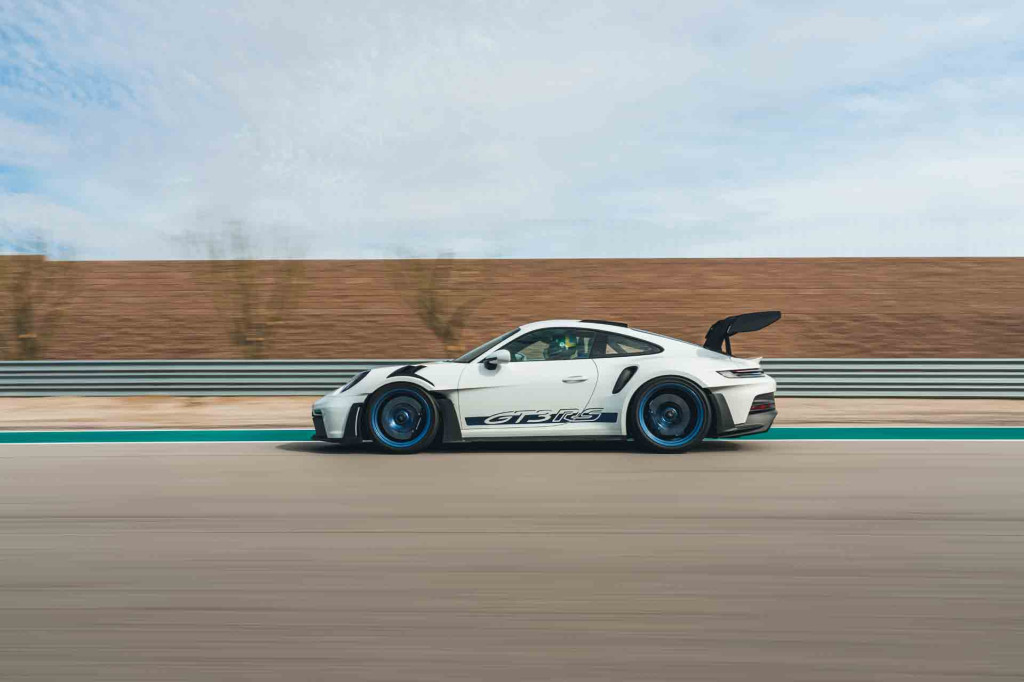
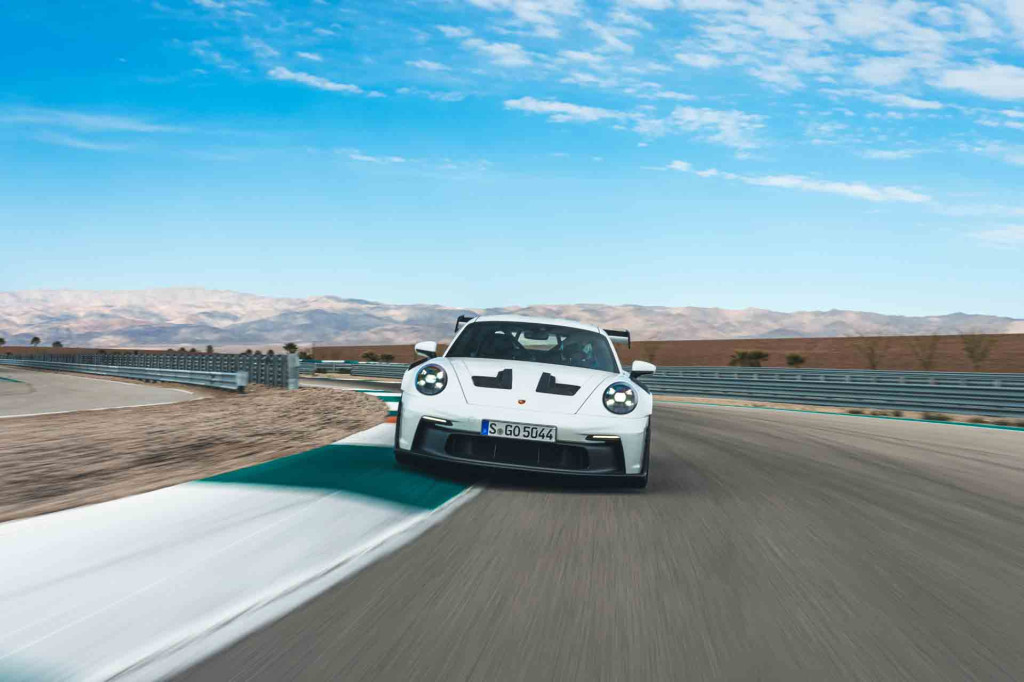

Session 3: Tracking the 911 GTS RS with differential adjustments
For my third session, I stick with the same damper settings, but Bergmeister suggests setting the limited-slip differential to -1 off throttle to let the car turn in even easier and +4 on throttle for more straight-line stability. He notes that I might want to try the latter setting and switch it back to 0 if I don’t like it. I press the PTV button on the steering wheel and make the proper adjustments, taking care to remember how to change them on the fly if I don’t like this setup.
I don’t like it. The GT3 RS may turn in a little sharper thanks to the -1 PTV setting, but it wants to go in a straight line when I’m on the throttle. This becomes clear in the esses that are part of the Desert course. These high-speed turns require me to carry as much speed as possible, let off just before the apexes, then quickly get back on it. Rinse and repeat three times, and I can choose to drive over the curbs to cut a straighter line while disrupting the car’s balance or make sharper turns by avoiding the curbs. After avoiding the first curb, I soon learn that I will need to hit the other two as the car just doesn’t want to turn in as sharply as expected at these speeds.
Once is enough for me, and on the next straight I hit the PTV button again to put the rear diff in its 0 on-throttle setting.
This is the last session of the day for journalists and this marks the ninth 10-12 minute session for this car. By now, the tires are starting to lose their grip and the car slides earlier in sharp corners. I’m back in the car with iron brakes, and they’re holding up as well as they did at the start of the day. I never fiddled with the traction and stability control settings, and I never felt it intercede to get me back on line.

Session 4: The perfect lap in the 911 GT3 RS
As a final bonus, I get a right-seat ridealong with Long at the wheel. He proceeds to show me what a perfect lap is, getting on the gas earlier and sliding the rear end in a controlled manner through the corners. He’s driving far more with the rear wheels than I did, and I can feel the car is almost always on the line between grip and chaos. He also carries more speed into the corners, no doubt exercising the downforce that I can’t quite feel.
The 2023 Porsche 911 GT3 RS is the ultimate expression of the 911’s track capability. It’s built to get the most out of the enormous performance envelope provided by the 911’s chassis, and its many chassis adjustments allow the driver to tweak how the car acts as it approaches its thresholds. The adjustments can be made to suit a racer’s driving style, the track conditions, or both. It’s like having a pit crew at your disposal, all automated on the steering wheel.
The 2023 Porsche 911 GT3 is more than just a street-legal race car. Some of its features, most notably the DRS and carbon-ceramic brakes, would be illegal in most racing associations. All that capability doesn’t come cheap. It starts at $225,250, and good luck getting on the list to get one at all, let alone at MSRP. However, those lucky enough to buy one will possess a track weapon that encourages the pursuit of the perfect lap.
Porsche provided airfare, lodging, and a thrilling President’s Day track experience for Motor Authority to bring you this firsthand report.


